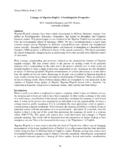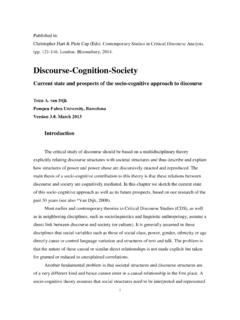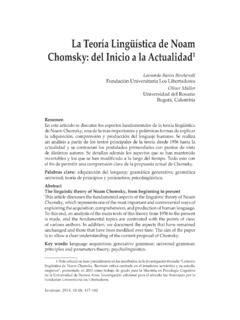Transcription of Why Use Music in English Language Learning? A Survey of ...
1 English Language Teaching; Vol. 6, No. 2; 2013. ISSN 1916-4742 E-ISSN 1916-4750. Published by Canadian Center of Science and Education Why Use Music in English Language Learning? A Survey of the Literature Dwayne Engh1. 1. English Teacher, Tudor BEC College London, (Received Masters in English Language Teaching and Applied Linguistics, King's College London, 2010). Correspondece: Dwayne Engh, St. Peter's Vicarage, 53 Belsize Square, London, NW3 4HY. E-mail: Received: December 9, 2012 Accepted: December 22, 2012 Online Published: January 9, 2013. URL: Abstract The use of Music and song in the English Language -learning classroom is not new. While many teachers intuitively feel that Music is beneficial in teaching English Language , there is sometimes a lack of the theoretical underpinnings that support such a choice.
2 There are examples in the literature to argue the strong relationship between Music and Language that are substantiated by research in the fields of cognitive science, anthropology, sociolinguistics, psycholinguistics, First Language Acquisition (FLA) and Second Language Acquisition (SLA). Keywords: Music , song, English Language learning 1. Introduction The use of Music and song in the English Language -learning classroom is not new. As early as Bartle (1962), Richards (1969) or Jolly (1975), scholars have been arguing for use of Music in a Language acquisition context for both its linguistic benefits and for the motivational interest it generates in Language learners. There are examples in the literature to argue the strong relationship between Music and Language that are substantiated by research in the fields of cognitive science, anthropology, sociolinguistics, psycholinguistics, First Language Acquisition (FLA) and Second Language Acquisition (SLA).
3 Music had been used on occasion with the Audiolingual Method in Language teaching classrooms to reduce the boredom that could occur from repetitive drills from the 1950s through to the 1970s (Bartle, 1962; Kanel, 2000) and later, the use of classical instrumental Music was used with the goal to produce a relaxed state of mind that makes the brain receptive to inputs and activates the subconscious in Suggestopedia methodology (Lozanov, 1978; see also Bancroft, 1978). However, it may not have been until Communicative Language Teaching (CLT) and Task Based Learning (TBL). approaches became more pervasive that there was a sudden demand for pedagogical material for the use of songs in the Language -learning classroom (Griffee, 2010).
4 Why is it Important? There were two important outcomes from the author's recent research (2010) into effective use of Music in the English Language classroom (in press). One suggested that there was strong support for use of Music in the Language -learning classroom, but that there was actually very little occurring in most classrooms. Connected, but a separate issue, implied that while many teachers intuitively felt Music was beneficial in teaching English Language , there was also the perception that there was a lack of understanding of the theoretical underpinnings that supported such a choice. Therefore, some educators felt unable to defend the decision to champion use of Music in the classroom to administrators, business English students or those in a predominantly exam focused environment.
5 Salcedo (2010), after a Survey of foreign Language teaching journals, suggests there are only a few articles on the subject compared to multitudinous articles on other methodological ideas . Other scholars have noted this as well: Coe (1972) stated there have been no controlled Music use in the Language classroom experiments and Griffee (1989), in an editorial introduction discussing why songs and Music aren't used more extensively in the Language classroom, suggests there exists a lack of theoretical perspective and empirically based research in the field. I would propose that, while there has been some progress in this subfield, little has changed throughout the past decades.
6 113. English Language Teaching Vol. 6, No. 2; 2013. Subsections of Literature Review In this literature review, I will examine academic perspectives from within the field of applied linguistics and will make connections to the field from other disciplines that argue there is a firm empirical, theoretical and pedagogical basis to consider for the use of Music as an aid in Language acquisition. The examination of the literature will consider the following five categories: 1. Sociological Considerations 2. Cognitive Science 3. First Language Acquisition 4. Second Language Acquisition 5. Practical Pedagogical Resources 2. Sociological Considerations There are four distinct sections in the exploration of Sociological Considerations that will be discussed.
7 Those include the areas of Anthropological Arguments, Community, Breaking Boundaries and Culture. Anthropological Arguments The connection of song to both the development of human languages and the linguistic development of the individual are anthropologically worth noting (Murphey, 1990). Livingstone (1973), in a contentious article that made extrapolations from physical anthropological research of birdsong and mammal behaviour, hypothesised that humans evolved song before speech. While this can never conclusively be proven (see Count, Hewes, Livingstone & Mourant, 1974 for counter-argument), it raises interesting connections to infant development and first Language acquisition research that will be discussed later in this review.
8 From a social anthropological perspective, Merriam (1964) has argued that the survival of literature, epic poetry and ballads in oral traditions must be credited to the use of song. The odes of praise and stories of the tribe were passed on through song so that the texts would not be forgotten before the written word developed. Rubin (1995) suggests this may be because of the multilayered patterns of rhythm, sound, linguistic meaning and emotional content functioning simultaneously. Lastly, drawing on anthropological and ethnomusicological literature, Trehub and Trainor (1998). examine the historical and cultural functions of songs in child care, claiming the descriptive evidence seems to suggest that the practice of singing to infants and many details of song form and style are rooted in ancient traditions that have survived industrialization and urbanization (43).
9 It does appear the anthropological development of human languages is, to some extent, connected to Music and song. Community In addition to being utilized by caregivers and individual storytellers in oral traditions, singing has also historically evolved as a collective activity. It is communally practiced by people not requiring professional training, with a wide range of experience levels, and in a variety of settings including leisure, religious or educational communities. It is argued that use of song in the Language classroom enhances social harmony (Huy Le, 1999), creates a safe space to experience learning collectively and contributes to the building of a community (Lems, 1996; Lake, 2003); all of which are essential factors for effectively attaining teaching and learning goals.
10 Specifically examining trust and cooperation, Anshel and Kipper (1988) suggest that group participation in singing positively influences both trust and cooperation, which are primary contributors to the progression of group cohesion and a sense of community (see McMillan & Chavis, 1986 for further discussion of theories of community). Gao (2008), while discussing use of karaoke and singing contests as evidence of learner collaboration in English Corners in China, approaches the humanistic learning that can occur within this type of community as following traditional Chinese cultural values and Confucian pedagogical traditions (see also Nguyen, Terlouw & Pilot, 2006). The literature appears to suggest that the specific feeling of belonging to a cohesive community, that many teachers explicitly strive to establish for their learners in the classroom, can be promoted by use of Music and collective singing.



















